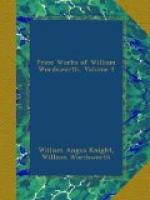Do you mean to have a short preface upon the construction of the sonnet? Though I have written so many, I have scarcely made up my own mind upon the subject. It should seem that the sonnet, like every other legitimate composition, ought to have a beginning, a middle, and an end; in other words, to consist of three parts, like the three propositions of a syllogism, if such an illustration may be used. But the frame of metre adopted by the Italians does not accord with this view; and, as adhered to by them, it seems to be, if not arbitrary, best fitted to a division of the sense into two parts, of eight and six lines each. Milton, however, has not submitted to this; in the better half of his sonnets the sense does not close with the rhyme at the eighth line, but overflows into the second portion of the metre. Now it has struck me that this is not done merely to gratify the ear by variety and freedom of sound, but also to aid in giving that pervading sense of intense unity in which the excellence of the sonnet has always seemed to me mainly to consist. Instead of looking at this composition as a piece of architecture, making a whole out of three parts, I have been much in the habit of preferring the image of an orbicular body,—a sphere, or a dew-drop. All this will appear to you a little fanciful; and I am well aware that a sonnet will often be found excellent, where the beginning, the middle, and the end are distinctly marked, and also where it is distinctly separated into two parts, to which, as I before observed, the strict Italian model, as they write it, is favourable. Of this last construction of sonnet, Russell’s upon ‘Philoctetes’ is a fine specimen; the first eight lines give the hardship of the case, the six last the consolation, or the per-contra.
Ever faithfully
Your much obliged
friend and servant,
W. WORDSWORTH.
P.S. In the case of the Cumberland poet, I overlooked a most pathetic circumstance. While he was lying under the tree, and his friends were saving what they could from the flames, he desired them to bring out the box that contained his papers, if possible. A person went back for it, but the bottom dropped out, and the papers fell into the flames and were consumed. Immediately upon hearing this, the poor old man expired.[137]
89. The Poems of Lady Winchelsea, Skelton, &c.
LETTER TO THE REV. ALEXANDER DYCE.
Lowther Castle,
Sept. 23 [qu. Aug. 1833.
No date of the Year.]




